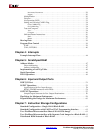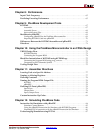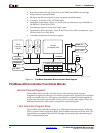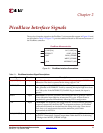
PicoBlaze 8-bit Embedded Microcontroller www.xilinx.com 15
UG129 (v1.1.2) June 24, 2008
Why the PicoBlaze Microcontroller?
R
The data registers and scratchpad RAM are not affected by Reset.
See “RESET Event” in Appendix C for more information.
Why the PicoBlaze Microcontroller?
There are literally dozens of 8-bit microcontroller architectures and instruction sets.
Modern FPGAs can efficiently implement practically any 8-bit microcontroller, and
available FPGA soft cores support popular instruction sets such as the PIC, 8051, AVR,
6502, 8080, and Z80 microcontrollers. Why use the PicoBlaze microcontroller instead of a
more popular instruction set?
The PicoBlaze microcontroller is specifically designed and optimized for the Spartan-3,
Virtex-II, and Virtex-II Pro FPGA architectures. Its compact yet capable architecture
consumes considerably less FPGA resources than comparable 8-bit microcontroller
architectures within an FPGA. Furthermore, the PicoBlaze microcontroller is provided as a
free, source-level VHDL file with royalty-free re-use within Xilinx FPGAs.
Some standalone microcontroller variants have a notorious reputation for becoming
obsolete. Because it is delivered as VHDL source, the PicoBlaze microcontroller is immune
to product obsolescence as the microcontroller can be retargeted to future generations of
Xilinx FPGAs, exploiting future cost reductions and feature enhancements. Furthermore,
the PicoBlaze microcontroller is expandable and extendable.
Before the advent of the PicoBlaze and MicroBlaze™ embedded processors, the
microcontroller resided externally to the FPGA, limiting the connectivity to other FPGA
functions and restricting overall interface performance. By contrast, the PicoBlaze
microcontroller is fully embedded in the FPGA with flexible, extensive on-chip
connectivity to other FPGA resources. Signals remain within the FPGA, improving overall
performance. The PicoBlaze microcontroller reduces system cost because it is a single-chip
solution, integrated within the FPGA and sometimes only occupying leftover FPGA
resources.
The PicoBlaze microcontroller is resource efficient. Consequently, complex applications are
sometimes best portioned across multiple PicoBlaze microcontrollers with each controller
implementing a particular function, for example, keyboard and display control, or system
management.
Why Use a Microcontroller within an FPGA?
Microcontrollers and FPGAs both successfully implement practically any digital logic
function. However, each has unique advantages in cost, performance, and ease of use.
Microcontrollers are well suited to control applications, especially with widely changing
requirements. The FPGA resources required to implement the microcontroller are
relatively constant. The same FPGA logic is re-used by the various microcontroller
instructions, conserving resources. The program memory requirements grow with
increasing complexity.
Programming control sequences or state machines in assembly code is often easier than
creating similar structures in FPGA logic.
Microcontrollers are typically limited by performance. Each instruction executes
sequentially. As an application increases in complexity, the number of instructions
required to implement the application grows and system performance decreases
accordingly. By contrast, performance in an FPGA is more flexible. For example, an
algorithm can be implemented sequentially or completely in parallel, depending on the


















